In this series, we introduce you to the four inspiring Ethiopian women with recipes to teach and stories of hope and courage to share.
I bend my head to walk through the doorway of Tsehay’s mud home. She flashes us a big grin, but doesn’t linger long over pleasantries. Today is baking day, in a home with eight children and a team of farm workers to feed. Talk about busy!
The flames beneath Tsehay’s tiny woodstove flash orange and red, licking the bottom of her cast-iron hot plate. I watch her dart about the room, a blur of perpetual motion. The business of home and family don’t stop for baking.
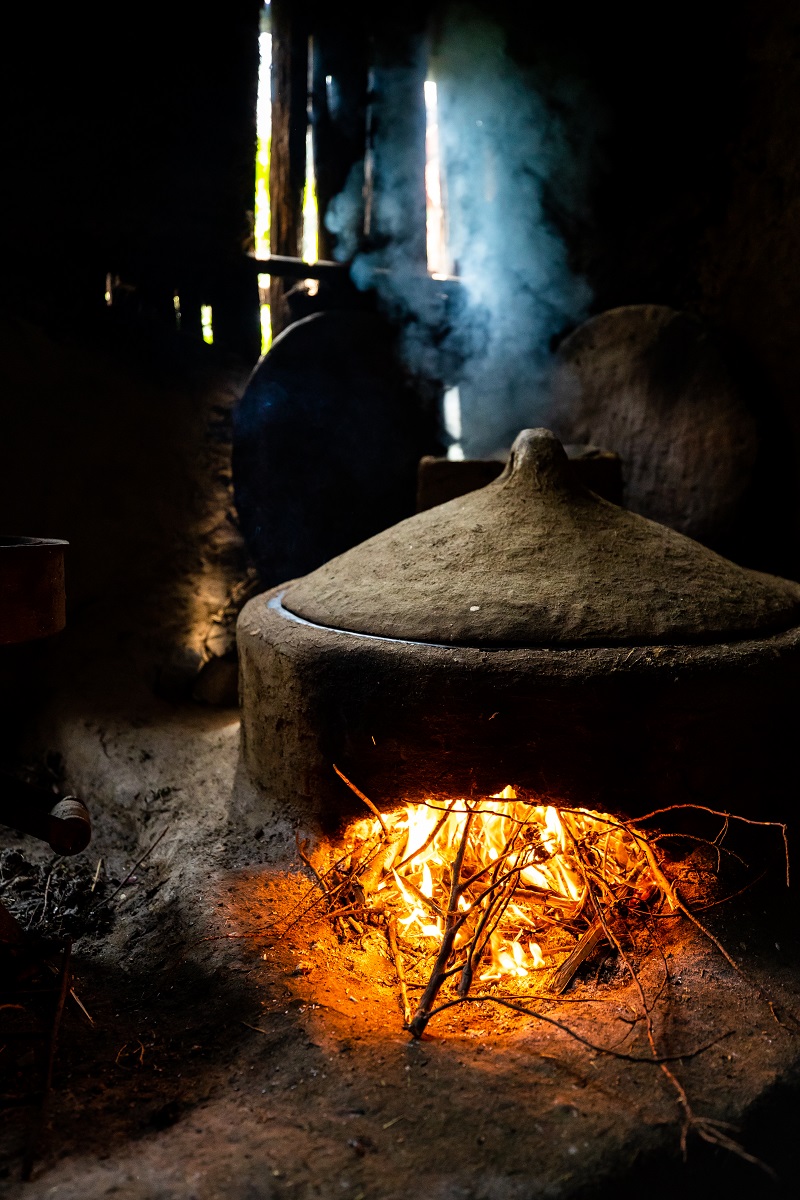
Stoking the fire to make injera! Photo: Dennis Prescott
I’m about to learn about a food I’ve enjoyed with every single meal since arriving in Ethiopia.
“Injera” is a pancake-like flatbread that’s so essential to mealtimes here. It’s even served on Ethiopian Airlines!
Injera doubles as both food and utensil. I’ve already learned to tear off pieces, using them to scoop and grasp the meats and vegetables that are ladled on top. The flatbread has a taste I’ve grown to love, almost like sourdough. I’ll soon taste it as fresh as it comes, straight from Tsehay’s hotplate.
It’s the moment I’ve been waiting for.
The foundation of meals
Injera is the foundation for all Ethiopian meals – but it’s more than that. The simple flatbread is a symbol of the people’s tenacity, their gift for turning the tiniest seeds into something powerful. This humble baked good comes loaded with the vital nutrients needed to grow strong, healthy children.
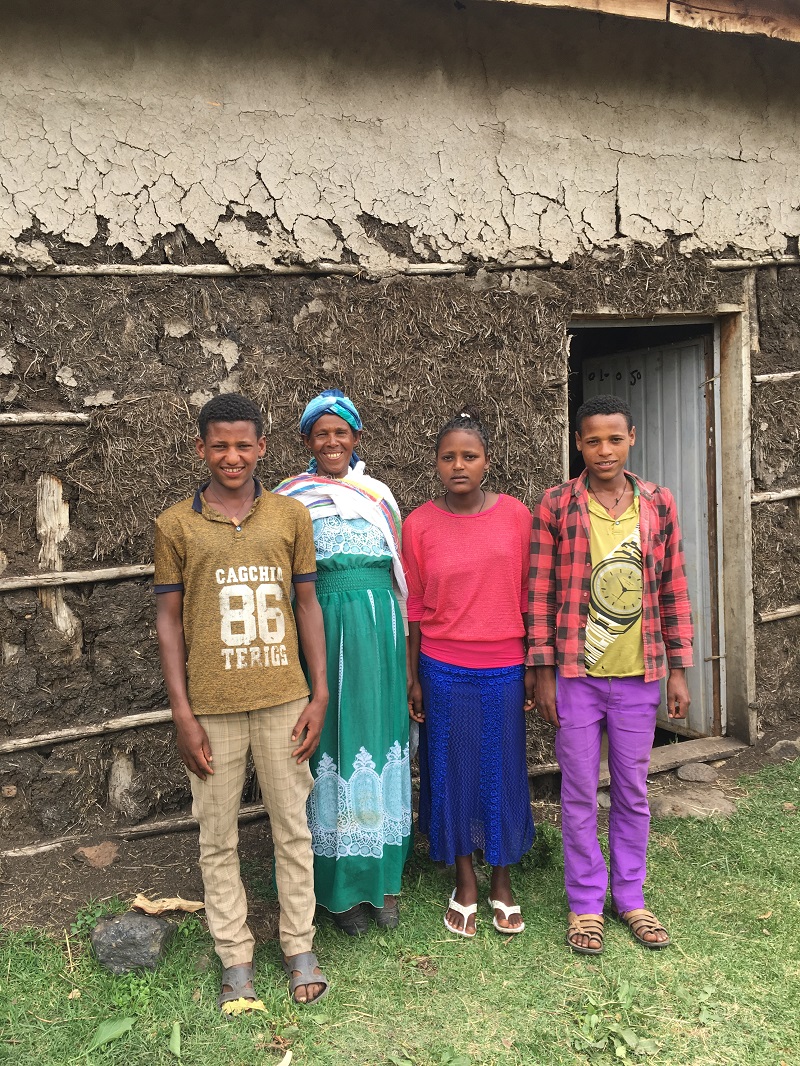 Tsehay with three of her eight healthy children, two of whom are sponsored. Photo: Brett Tarver
Tsehay with three of her eight healthy children, two of whom are sponsored. Photo: Brett Tarver
As she works, Tsehay tells us about her family. Her husband died a few years ago. She’s now raising eight kids herself – and that’s no small feat. Just feeding them consumes large portions of Tsehay’s workdays.
While pouring the batter, Tsehay describes how she raises her own grains, fruits and vegetables, swapping them for other goods through a local gardening cooperative. Bellies throughout the community are filled with delicious colourful, nutrient-rich options.
As she hosts us, Tsehay is also tending to the preparation of a big lunch for migrant farm hands who are working the community lands. It’s the beginning of planting season, and the farms are hives of activity.
But Tsehay is patient and good-natured, showing us visitors how Ethiopians make their daily bread. Her hands work quickly and deftly, as the home fills with the wonderful aroma of fresh-baked bread.
The tiny wonder grain
Swaying in the breeze outside is Tsehay’s crop of the wispy Ethiopian grain ‘teff’. Many thousands of years before it was domesticated, teff grew wild on the plains. Now, it holds a place of honour, as the country’s staple crop. Culturally, it’s one of the most significant parts of the Ethiopian diet.
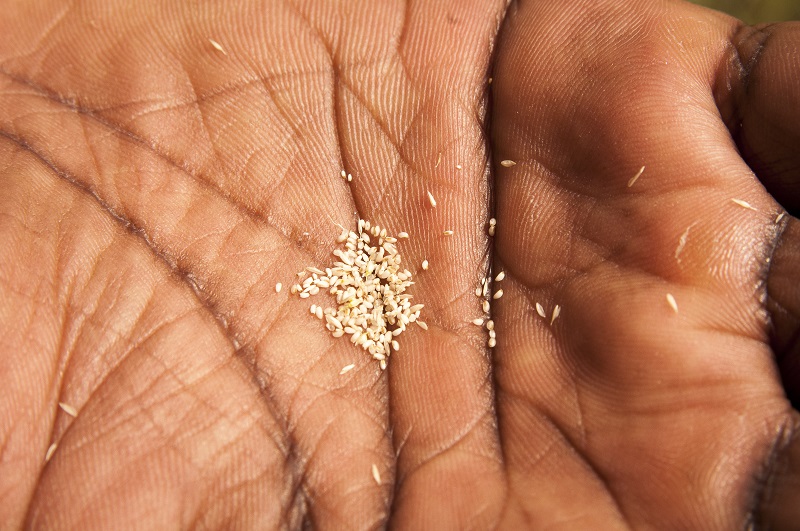
Teff grains are so tiny! Photo: Adobe Stock
Tsehay opens her palm, showing me a handful of teff grain. For children across Ethiopia, teff builds health and fuels growth. It’s an excellent source of protein, rich in minerals of all kinds. Ground up and baked into injera, tiny teff is higher in several key nutrients than corn, rice, or even wheat.
Tsehay shows us how she mixed the teff with water and yeast three days ago, before allowing it to ferment. Baking happens on the third day after mixing, the results of which are enjoyed with savoury stews and soups.
Farm straight to table
This is the ultimate farm-to-table scenario. Tsehay’s strong, calloused hands till the soil, and tend the plants as they grow. They harvest and grind the grain. They mix the batter, and pour it in spirals onto the hotplate.
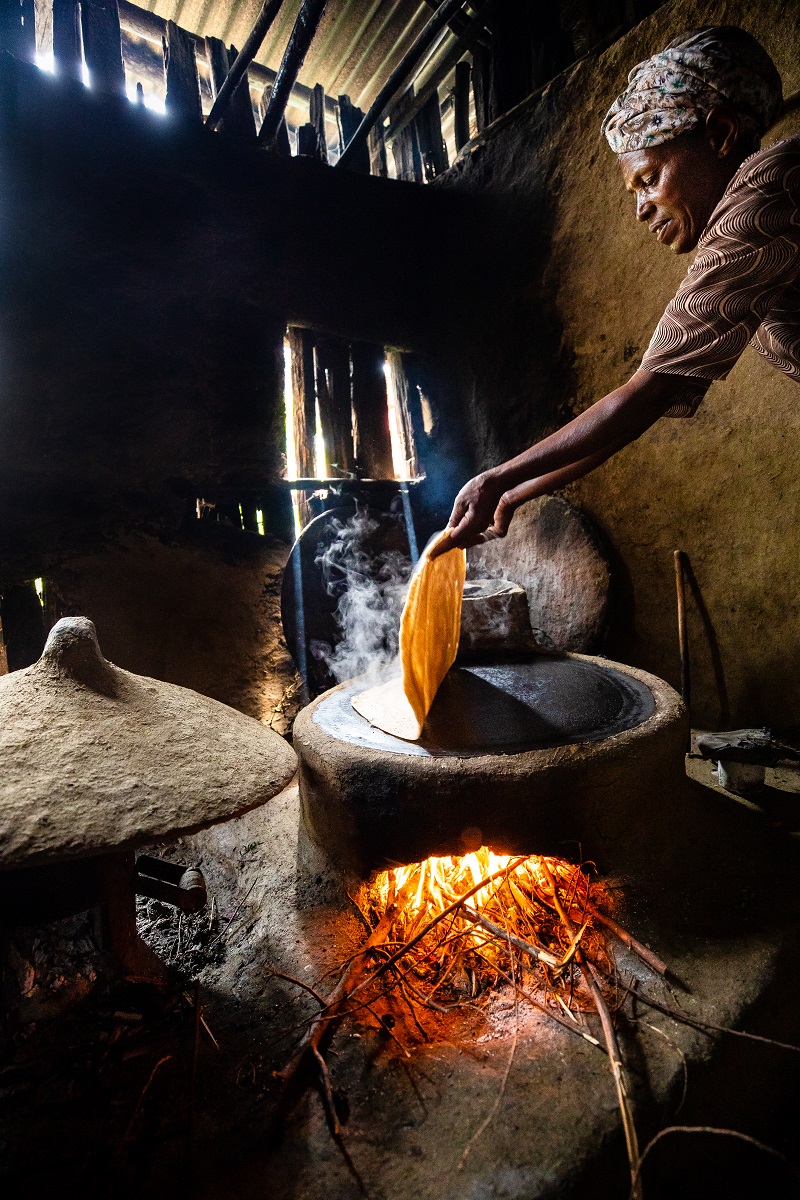 Tsehay makes injera on her new stove. Photo: Dennis Prescott
Tsehay makes injera on her new stove. Photo: Dennis Prescott
These hands have made injera for more than three decades. Tsehay begun learning in the years shortly after Ethiopia’s great famine in the 80s. She was a slight, eager girl of 12 at her mother’s side.
Eventually, Tsehay was ready for the great right rite of passage. She was at last strong enough, responsible enough, to command the fire and hotplate. She had the quickness of touch to lift the flatbread with her bare hands, without burning her fingers too often.
“My mother taught me how to make injera,” smiles Tsehay. “Everyone here learns from their mother. Or their aunt or grandmother.”
The passing of wisdom from one generation to the next. I thought of my own two daughters back in Canada, remembering how they’re learning to bake banana bread from their own mother.
Having learned, they will never forget. And one day, they’ll pass the tradition to their own children. It’s these shared memories, this received knowledge, that keeps families strong.
The difference a stove makes
But injera is different than holiday baking in Canada, which usually happens in a modern oven powered by electricity.
“Injera can be dangerous to make,” explains Tsehay, lifting the edge of the pancake to see how it’s browning underneath. It’s looking good, almost ready to flip. “Little girls here do dishes and help with mixing until they’re old enough to handle the fire and stove.”
Cooking is much safer and healthier now, than in Tsehay’s girlhood. She recently received two small, high efficiency cook stoves through a World Vision program. One is a large hot plate, just for cooking injera.
Before the stoves, women and girls would balance the hotplate precariously, on three rocks over an open fire. They would also have to spend up to four hours a day foraging for firewood.
This was the main cause of deforestation here. And wandering alone in the woods – where girls and women could be exploited or even kidnapped – was far more dangerous than making injera.
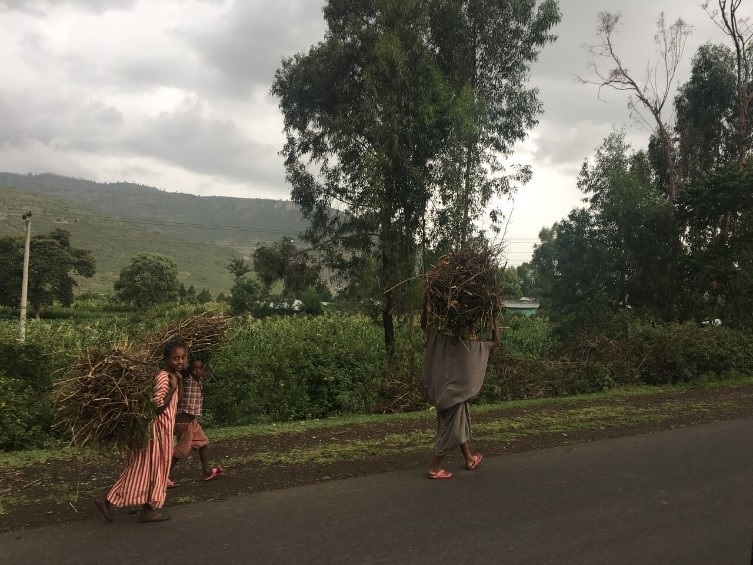
Children gather firewood in Ethiopia. Photo: Brett Tarver
The high-efficiency stoves relieved this fear. And they’re so much healthier. No longer do families inhale the thick smoke.
Tasting the rewards
The injera is ready! Tsehay’s made dozens now, laying them flat in a woven basket, or “sefed”. As the baked goods pile up, they’ve been transferred to a larger basket, or “mesob”.
I wish I could stay for dinner. I’m growing fond of the traditions here. You can only use your right hand for eating. You take the portion directly in front of you. Don’t lick your fingers! And start each meal with “gursha”, the endearing practice of feeding someone you love with your hands.
There is an Ethiopian saying: “those who eat alone, die alone”. It sounds ominous, but speaks to just how much “food is community” every meal of every day. Spending time in Tsehay’s home, I’ve felt like a member of that community – that family, as warm as the fresh injera.
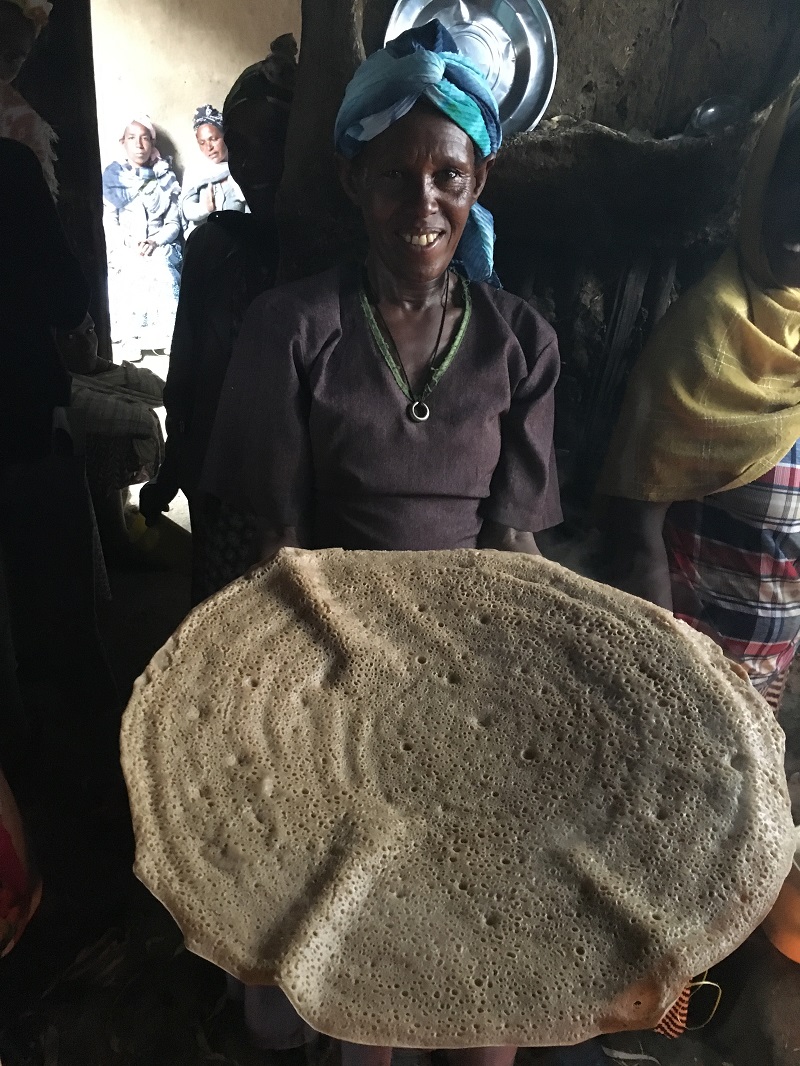 The delicious, nutrient-packed finished product! Photo: Brett Tarver
The delicious, nutrient-packed finished product! Photo: Brett Tarver